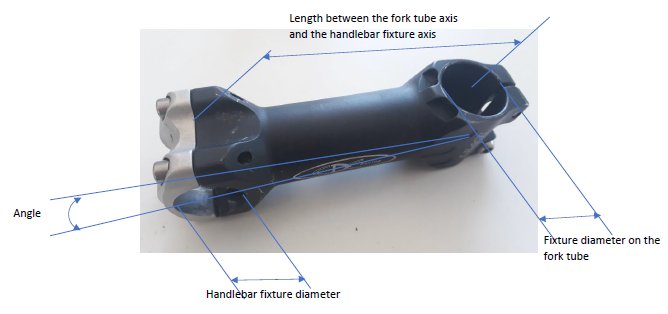A diagram of the characteristics and specificities of a bicycle stem can be useful to understand its different parts and the way in which they influence riding and comfort. Here's a detailed look at the key parts of a bicycle stem and the features to consider when choosing one.
Dimensions of a bike stem:
The choice of the bike stem dimensions can be classified into two parts:
• The fixing diameter with the fork tube and that of the handlebar
• The length and angle
The length of a bike stem is measured between the axis of the fork tube and the axis of the handlebar.

The angle is given between a horizontal line and the axis of the bike stem.
Diagram of the main components of a bicycle stem
A typical bicycle stem diagram includes the following elements:
1. Stem body:
The main part that connects the handlebars to the steering column. The body is often made from aluminum, carbon, or sometimes steel. Body length and material influence stiffness, weight and ergonomics.
2. Faceplate:
Front part of the stem which serves to attach the handlebars to the body. It usually has four screws to hold the handlebars securely in place. The faceplates can be straight or slightly curved to better distribute pressure on the handlebars and prevent slipping.
3. Stem angle (rise angle):
The angle of the stem determines the inclination of the handlebars. It is often stated in degrees, for example -6°, -8°, +6°, etc. Negative angles lower the handlebars for a more aerodynamic position, while positive angles raise the handlebars, providing a more comfortable position.
4. Stem length:
The distance between the handlebar mount and the steering column, measured in millimeters. Short lengths (60-80mm) provide increased maneuverability, often used in mountain biking and gravel, while longer lengths (100-130mm) are common in road biking for a recumbent, aerodynamic position.
5. Fixing the steering column:
The part of the stem that attaches to the fork of the bicycle. It is often designed for a 1"1/8 (28.6 mm) diameter head tube, which has become standard on most modern bicycles.
6. Clamping system:
One or two bolts placed at the rear of the stem secure the stem body to the steering column, providing stability to the handlebars. Clamping systems can be direct or fitted with a flange for better pressure distribution.
Important features of a bicycle stem
1. Material:
Aluminum stems are lightweight, affordable and stiff enough for most uses. Carbon, lighter and more expensive, absorbs vibrations better and is often preferred for the road.
2. Adjustable angle vs. fixed :
Some stems are adjustable, allowing you to adjust the inclination of the handlebars. This is particularly practical for city bikes and trekking bikes, where a more upright position is desired. Fixed stems, which are lighter, are better suited to road and competition bikes.
3. Handlebar attachment type:
The diameter of the handlebar mount is critical to ensure compatibility. The most common standards are 31.8mm (oversize) and 25.4mm (classic), the former being more common on modern bikes.
Specifics to consider
1. Intended use:
Short, high-angle stems are common in mountain biking for maneuverability, while long, raked stems are preferred on the road for aerodynamics.
2. Ergonomics:
A good stem must correspond to the cyclist's body shape to avoid back and shoulder pain, especially over long distances.
3. Weight:
An important criterion in competition, where every gram counts, carbon stems are often preferred for their extreme lightness, while aluminum is a more economical choice without sacrificing robustness.
In summary, the bicycle stem plays a central role in adjusting the riding position, influencing stability, comfort and handling. A well-detailed diagram allows you to better understand the importance of each component and to optimize the choice of a stem adapted to each type of practice.
To go further:
- Bike stem length, how to determine it?
- What is a bicycle stem ?
